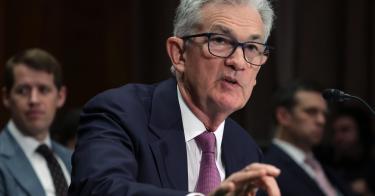Americans are being taxed an extra $800 million a day—that’s $292 billion a year—to enrich special interests in the financial sector, and the Federal Reserve is doing it in the name of monetary policy. What’s worse is that the Fed has no exit strategy for this conundrum, and the pain for the public is going to get worse.
Shortly after President Biden took office, the Fed faced a problem: It sought to create trillions of dollars for the government to spend, but it also wanted to minimize the inflationary impact of all that money printing—two diametrically opposed goals. The Fed decided to square the circle using reverse repurchase agreements, called “reverse repos.”
A reverse repo is basically a short-term loan to the Fed. But why would the Fed need a loan when it can create money at will? The Fed doesn’t need a loan—it needs to temporarily soak up excess liquidity, which effectively reduces the amount of money in circulation.
As the Fed created trillions of dollars for the government to spend, those dollars worked their way through the banking system and multiplied, a phenomenon that occurs courtesy of fractional reserve banking. For every dollar the Fed created, the banking system created several more, and that tsunami of liquidity gave us 40-year-high inflation.
>>> We Traded a Debt Crisis for an Inflation Crisis, and Now We Have Both
As bad as inflation has been, it would’ve been worse, but reverse repos provided a braking action by short-circuiting the multiplication of money that normally occurs in the banking system. Over $2 trillion is being “sterilized” by the Fed daily, preventing that money from flowing into the private economy.
But the Fed can’t just force banks, hedge funds, and other holders of cash to park their money in the vaults of the Fed. The central bank pays interest on reverse repos—they are loans, after all. Instead of being a stopgap measure to quickly absorb liquidity, reverse repos have become normal operating procedure under Chairman Jerome Powell, like how former Chairman Ben Bernanke paid banks interest for keeping extra deposits parked at the Fed.
But unlike Mr. Bernanke’s interest-on-reserves policy, Mr. Powell’s reverse-repo operations are available to financial interests beyond just big banks. Hedge funds, government-sponsored entities and others can park their cash at the Fed for a risk-free rate of return.
And what a return it is—the Fed is paying $800 million daily in interest on $6 trillion between bank reserves and reverse repos. Amazingly, in the name of fighting inflation, the Fed is now creating almost $300 billion via these interest payments. And those payments are going to large money interests, not the American people.
Instead, Americans are footing the bill. Under normal operations, the Fed actually makes a relatively small profit, which it turns over to the Treasury, payments known as remittances. Today, however, the Fed is deeply in the red, largely because it’s funneling $800 million to Wall Street daily. Despite selling hundreds of billions of dollars in securities, the Fed has accrued a $70 billion loss since August 2022.
>>> Biden’s Bank Bailouts Costing Customers
It takes a special level of incompetence to possess the power to print money and still suffer a loss.
Regardless of the ineptitude at the Fed, these monetary machinations are a transfer of wealth from the American people to big-money interests. They are corporate welfare under the guise of monetary policy. Yet the Fed has painted itself into a corner and can’t simply shut the machine down.
If the Fed stops the interest on reserve policy and reverse repo operations, $6 trillion will flood into the economy, multiply, and spark even worse inflation, prompting even faster and larger interest rate increases. If the Fed continues on its current path, the immediate consequence will be starving the private market for capital. But all those interest payments will also add up over time, creating their own inflationary pressures.
In short, the Fed has created a no-win situation for the American people while ensuring that the politicians and special interests still get paid.
This piece originally appeared in The Washington Times




